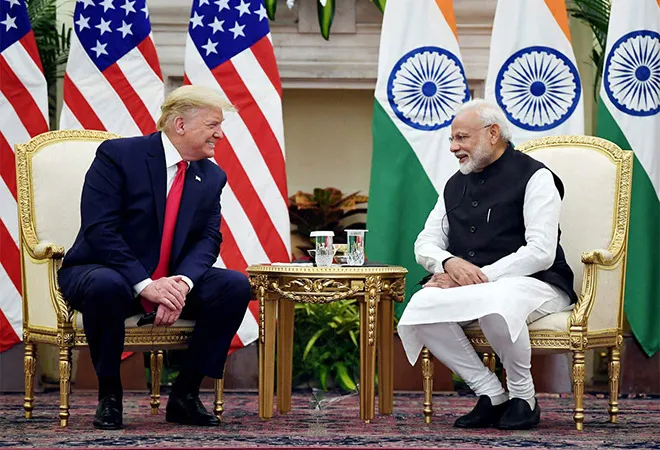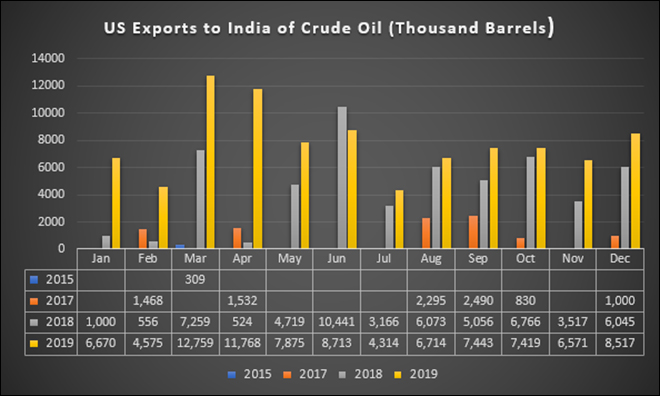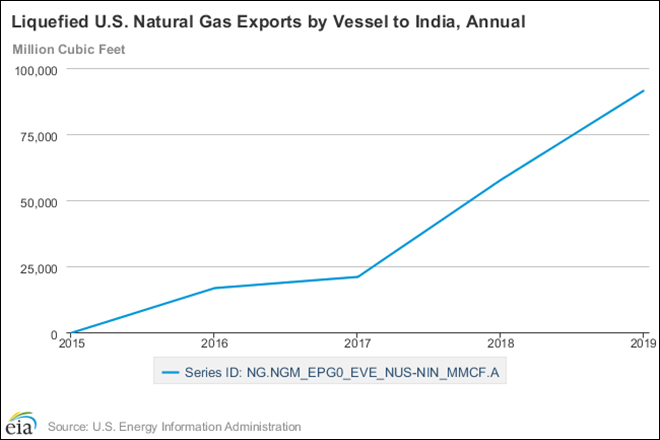
In a run-up to the US presidential election in November this year, US President Donald Trump’s maiden visit to India on February 24-25, 2020 was viewed as important, particularly, with the possibility of signing up for a new trade deal between India and the US. However, with the statement by President Trump of saving a ‘big trade deal’ with India only after the presidential election is over, should be viewed as a pragmatic one. None of these democracies would go-ahead to seal a fair and sustainable deal without settling down their trade disagreements, which could create a win-win condition to their countries, giving priority to their respective national interests.
The US, under the Trump Administration, is striving hard to bridge its huge deficit with its Asian trading partners like China and India. However, in recent times, there have been strikingly different trends seen in the trade deficits of the US with these countries. While, in case of China the ever-increasing U.S. goods trade deficit since 1985 has jumped by 11.6% in 2018, compared to 2017, to register at $419.2 billion, in case of India, this trade deficit has fallen down by 9% in 2018, over 2017, that stood at $20.8 billion. Thanks to the complementary nature of hydrocarbon exports of the US to India, which not only succeeded in replacing Iranian crudes but also help meet India’s natural gas demand, through liquified natural gas (LNG) exports, from a new source, in addition to existing places like Qatar, Russia, and Australia under long-term gas supply deals.
According to US energy secretary Dan Brouillette, ‘In the last two years, we have seen a remarkable offtake in the US oil and gas by India, from 25,000 bpd in 2017 to 250,000 bpd now, a 10-fold increase and we expect it to be better from here’.
Till December 2019, there has been a remarkable increase in crude oil imports to the tune of over 9 million tonnes, accounting for 88% increase over 2018. India increased its oil imports from the US to replace Iranian oil starting from 2017 as shown in following table.
 Source: US Energy Information Administration
Source: US Energy Information Administration
Further, LNG imports from the US are expected to reach at least $576 million in 2020 from just $155 million in 2017. According to the US Department of Energy, India was the sixth-ranked nation for US LNG exports during the period from February 2016 to November 2019, constituting 5.1% of total LNG exports. The increase in LNG imports accelerated further after 2018.

Therefore, it is an uptick of hydrocarbon exports from the US, as a result of its shale boom and particularly after the removal of a four-decade oil export ban, that has helped in narrowing down its trade deficit with India. This hydrocarbon trade, according to Indian Petroleum Minister, Dharmendra Pradhan, ‘has increased exponentially during the last three years, and it touched US $7.7 billion mark last year, accounting for 11 per cent of total two-way trade’. Also, appreciating the great potential of Indo-US bilateral relationship, India’s ambassador to the US, Taranjit Singh Sandhu, stated that, “Our energy trade touched close to USD 8 billion last year. Mind you, this was zero, a few years ago.”
However, India-US Strategic Energy Partnership (SEP) is not just confined to trade and investments in hydrocarbons, but as per the comprehensive joint statement, it also seeks to enhance energy security through innovation linkages across the energy value chain. As noted in SEP this linkages, in turn, would bolster strategic alignment and facilitate increased engagement between industry and other stakeholders in the energy sector. The key areas of engagement under SEP were to pursue four primary pillars of cooperation, namely, Oil and Gas; Power and Energy Efficiency; Renewable Energy and Sustainable Growth; and Coal.
During President Trump’s visit to Delhi, three cooperation agreements on the energy sector were expected to be signed with respect to the export of increased crude oil and LNG at discounted rates and supply of nuclear reactors. Rather, ExxonMobil India LNG has signed a letter of cooperation with Indian Oil Corporation and Chart Energy & Chemicals to help build a virtual pipeline system. In order to increase the distribution of natural gas more rapidly and to new cities, this system will deliver LNG by road, rail, and waterways to areas not connected by physical pipelines. Under Indian Virtual Pipeline Initiative, the parties would implement an infrastructure that can move gas molecules in a reliable, cleaner and cost-effective way that would help push India’s gas-based economic vision, wherein a target is set to increase the share of natural gas in India’s energy basket from current 6.2% to 15% by 2030.
As regard to the three pacts expected to be signed, the first pact was related to increasing India’s LNG imports from the US, wherein Petronet LNG Limited was supposed to sign a 2.5 billion agreement with the US’s natural gas company, Tellurian Inc. Accordingly, India would import 5 million tonnes of LNG at an expected delivered price in the range of $6-8 per million British thermal units (MMBtu), compared to earlier concluded deals priced in the range of $9-10 per MMBtu, thereby reducing the cost of LNG imports, significantly. India’s LNG imports for the FY 2019 accounts for 47% of the total natural gas consumption. However, according to the report in The Hindu, this deal is now expected to be ready by the end of March this year.
As far as the sale of nuclear reactors is concerned, both President Trump and Prime Minister Modi encouraged Westinghouse and Nuclear Power Corporation of India to conclude the deal at the earliest, as both the countries failed to fix the issue pertaining to India’s nuclear liability law, during President Trump’s visit.
The third and the final pact that was expected to be signed between India and the US was the concessional oil exports to Indian refineries such as Indian Oil Corporation, Mangalore Refinery, and Petrochemicals and Nayara Energy. India’s ten-fold jump in oil imports from the US in the last few years to 2,50,000 barrels per day raised hopes for the possibility of this concession. Accordingly, a discount of $2-5 a barrel on the US oil to Dubai crude and high credit period of 60-90 days was on cards. The fate of such concession to India is still not clear, even as Indian refiners are able to import crude oil bound to China at deep discounts of up to $49 a barrel, resulting from the impact of coronavirus on oil markets.
Both the countries also welcomed the announcement of a $600 million financing facility for renewable energy projects, including solar and wind, in India by International Development Finance Corporation (DFC), an American development bank.
Going beyond the joint statement, both the countries should build upon their SEP to make it more sustainable. As a first step to realizing the full potential of the SEP, the US-India Gas Task Force can find new means to tap India’s unconventional resources, including shale gas prospects, which Oil and Natural Gas Corporation has wound up last year. Under this mechanism, India, with the help of the US should create an ecosystem that can reignite efforts through innovative means and adequate regulatory support.
Besides, with stringent emission norms and India’s goal to move towards ultra-supercritical power plants, the US should cooperate with India in providing clean coal technologies, while promoting efficiency improvements at existing coal plants in a cost-effective way. Clean coal technologies reduce the emission of pollutants and offer the possibility for future carbon capture and sequestration.
Further, good energy data management is key to monitoring energy policy and tracking their progress, however, there is no one-stop-shop for energy data in India. This creates yet another opportunity for both countries to strengthen and streamline their existing energy cooperation. Earlier, United States Agency for International Development, US Energy Information Administration and NITI Aayog has already signed cooperation to support a nodal agency for Energy Data Management, which should be reviewed and taken forward.
Thus, the US would do well to have a closer look at India’s energy market and offer energy solutions based on opportunities in India, not just through energy exports but by providing affordable and clean energy, that helps India uplift its poor. Finding opportunities at the decentralized level would deepen the scope and optimize US energy cooperation with India.
The views expressed above belong to the author(s). ORF research and analyses now available on Telegram! Click here to access our curated content — blogs, longforms and interviews.




 Source: US Energy Information Administration
Source: US Energy Information Administration
 PREV
PREV


